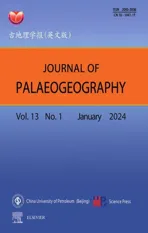Biological sources, paleoenvironment, and organic matter enrichment in source rocks of the Ordovician Majiagou Formation, Ordos Basin, China: Evidence from biomarkers,microfossils, and inorganic geochemical analyses
2024-01-25JingJingCaoWenZheGangShangRuYang
Jing-Jing Cao , Wen-Zhe Gang ,*, Shang-Ru Yang
a State Key Laboratory of Petroleum Resources and Prospecting, China University of Petroleum (Beijing),Beijing 102249, China
b College of Geosciences, China University of Petroleum (Beijing), Beijing 102249, China
c Oil and Gas Technology Research Institute,PetroChina Changqing Oilfield Company,Xi'an 710018,Shaanxi Province, China
Abstract Carbonate deposits in the Ordovivian Majiagou Formation are significant source rocks for natural gas generation in the Ordos Basin,northwestern China.Previous studies mainly focused on the organic matter enrichment mechanism of shales rather than carbonate rocks.The biological sources and paleoenvironment of carbonate source rocks,and the main controlling factors of organic matter enrichment in the carbonate source rocks were studied in this paper in combination with evidence from biomarkers, microfossils and inorganic geochemistry analysis.The results show that four types of microfacies were identified in the Majiagou Formation,respectively as:mud flat microfacies,mud—dolomite flat microfacies,dolomite flat microfacies, and open marine microfacies.The biological sources of organic matter are chiefly planktonic algae, followed by bacteria.The mud flat and mud—dolomite flat contain a high abundance of terrigenous detrital inputs, as indicated by the high content of Al2O3,TiO2,Th,and Zr.The low Sr/Cu and high Rb/Sr values reveal warm and humid paleoclimate conditions in the mud flat and mud—dolomite flat, whereas the dolomite flat and open marine were likely formed in hot and arid paleoclimate conditions.The mud flat and mud—dolomite flat deposits were characterized by high paleoproductivity of the Majiagou Formation.Low Sr/Ba values were found in the mud flat samples, indicating fresh to brackish water condition, whereas samples of other facies have a relatively high degree of salinity.Based on Uauth, Moauth, Crauth, Coauth, δCe, and δEu values, the mud flat microfacies was formed in a suboxic and anoxic environment, whereas the mud—dolomite flat, dolomite flat and open marine microfacies were within dysoxic to oxic conditions.A model of organic matter enrichment in the Majiagou Formation is thus established.The level of terrigenous detrital inputs is the principal factor of organic matter enrichment in the Majiagou Formation, secondly are redox condition and then paleoproductivity.The mud flat and mud—dolomite flat microfacies show abundant terrestrial detrital inputs and nutrient elements,indicative of warm and humid climate that facilitated biotic productivity,including an abundance of planktonic algae(microfossils).The suboxic and anoxic environments promoted the preservation of organic matter,as evidenced by the relatively high TOC content.The mud flat as well as the mud—dolomite flat of the Majiagou Formation is prospecting for forming source rocks.
Keywords Biological source, Microfacies, Trace elements, Organic matter, Majiagou Formation, Ordos Basin
1.Introduction
A natural gas accumulation with a commercial gas flow equivalent of 20.73 × 104m3/d was discovered in the fourth member of the Majiagou Formation(Fu et al.,2021).The significant potential of the gas accumulation in the Majiagou Formation has been confirmed (Ren et al.,2021).Oil-derived gas with high maturity in the Majiagou Formation was derived from the Ordovician in situ marine source rocks,and the carbonate source rocks in the Majiagou Formation can act as potential gas source rocks(Li et al.,2017;Ren et al.,2021).The relationships between geochemistry, sedimentary environment, and organic matter enrichment of the Majiagou Formation have been well studied(Shi et al.,2009; Wang et al., 2018; Li et al., 2020).However,further studies on the source and mechanism of organic matter enrichment controlled by multiple factors in source rocks of the Majiagou Formation are still necessary.Previous studies revealed that the Majiagou Formation was mainly shallow-marine sedimentation at relatively low paleolatitudes (0—30°south) under the background of dry and hot climate(Wang et al.,2018).The depositional environment has an important effect onorganic matterenrichment ofsourcerocks,which can be reconstructed by the characteristics of carbon and oxygen isotopes, inorganic elements, and biomarkers(Wang et al.,2018;Li et al.,2020).Major and trace elements have been widely used to determine paleoenvironmental conditions (Algeo and Maynard, 2004;Algeo and Tribovillard, 2009).In addition, paleoproductivity and preservation condition are the two critical factors that determine organic matter enrichment(Pedersen and Calvert,1990;Arthur and Sageman,1994).The degree of organic matter enrichment of source rocks is controlled by multiple factors, such as redox conditions (Arthur and Sageman, 1994),paleosalinity(Degens and Paluska,1979),sedimentation rate and terrigenous detrital input(Murphy etal.,2000).
In this study,the petrological and sedimentological characteristics of carbonate source rocks in the Majiagou Formation, Ordos Basin were described in detail based on microfacies analysis (Flügel, 2004).In addition, biological sources of organic matter were comprehensively identified on the basis of stable carbon isotopes, biomarkers, and scanning electron microscope (SEM) observations.The paleoenvironments were reconstructed based on major and trace elements and organic geochemistry,after eliminating the influence of terrigenous detrital inputs.On the base of the above results, a model of organic matter enrichment in the Majiagou Formation was established to reveal the effect of the paleoenvironment on organic matter enrichment during deposition.
2.Geological setting

Fig.1 A) Geological unit division map and the location of the studied wells in the Ordos Basin, China.Note that location map of the Ordos Basin was modified after the Standard Map Service of the National Administration of Surveying,Mapping and Geoinformation of China(http://bzdt.ch.mnr.gov.cn/),GS(2023)2763;B)Paleogeomorphic map during deposition of the Majiagou Formation (modified from Hu et al.,2022)and C)Seismic section flattened by the top of the Majiagou Formation(modified from Wu et al.,2021).The study area is located in the mideastern Ordos Basin.The paleogeomorphology and seismic horizon flattening results of the Majiagou Formation indicate that two secondary depressions were respectively developed in the eastern and western parts of the study area.
The Ordos Basin is the second largest petroliferous basin in China, covering an area of approximately 25 × 104km2(Xiao et al., 2019; Xiong et al., 2020)(Fig.1A).The Ordos Basin comprises six tectonic units:the Yimeng Uplift, Western Thrust Belt, Tianhuan Depression, Jinxi Fault—Fold Belt, Yishan Slope, and Weibei Uplift, according to current structural characteristics (Yang et al., 2018; Liu et al., 2020) (Fig.1A).The Lower Ordovician strata in this area are composed of Yeli and Liangjiashan formations, and the Middle Ordovician strata are consisted of Majiagou Formation (Li et al.,2020).The paleogeomorphology of the Majiagou Formation indicates that two secondary depressions were respectively developed in the study area(Fig.1B).The seismic horizon flattening results reveal that the thickness of the Majiagou Formation gradually decreases towards the surrounding area of the depression(Fig.1B and C).Lithologically the Majiagou Formation mainly consists of carbonate rocks interbedded with evaporates and mudstones (Shi et al., 2009; Fu et al., 2017).The Majiagou Formation is subdivided into first(Om1)to sixth(Om6)members from bottom to top according to lithological differences (Xiao et al., 2019; Liu et al., 2020)(Fig.2).The Om6member was denudated and lost because of weathering and erosion after the Ordovician in the mid-eastern Ordos Basin (Shi et al., 2009; Fu et al., 2017).The Om1, Om3, and Om5members were deposited during regressive periods,consisting of dolomite rocks, salt rocks, and gypsum rocks; whereas the Om2,Om4,and Om6members were deposited during the transgressive period, consisting of primarily dolomite and limestone(Fig.2)(Li et al.,2020;Liu et al.,2020).The Om5member is subdivided into 10 parts: Om51to Om510, extending from top to bottom according to the differences in depositional sequences and cyclical lithological characteristics (Liu et al., 2020; Xiong et al.,2020) (Fig.2).The Majiagou Formation is characterized by transgressive—regressive cycles because of periodic sea-level changes(Fu et al.,2017)(Fig.2).
3.Material and methods
3.1.Total organic carbon (TOC)
Thirty-five carbonate core samples were selected from the Majiagou Formation of the Ordos Basin for total organic carbon (TOC) content analysis.Four samples represented mud flat microfacies, eleven samples represented mud-dolomite flat microfacies,eleven samples were from dolomite flat microfacies and nine samples came from open marine microfacies.The TOC (wt.%) of the samples were determined by using a LECOCS-230 carbon/sulfur analyzer at the Laboratory of Geochemistry, China University of Petroleum (Beijing).Before the experiment, the source rock samples were crushed to a particle size less than 0.18 mm (80 mesh) and dissolved in hydrochloric acid solution to remove the carbonate.Iron and tungsten cosolvent (1.0 g each) was then added to the dried sample in the crucible.The analytical precision of the TOC measurements was better than ±0.05%.
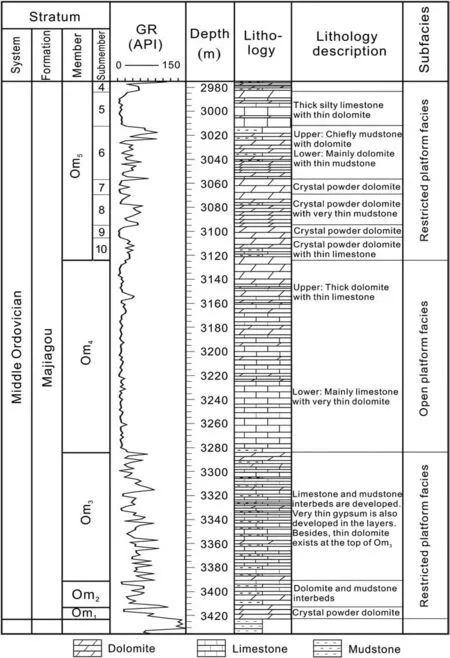
Fig.2 Stratigraphic column and depositional environment of the Majiagou Formation from Well Tao111 in the mid-eastern Ordos Basin.The Majiagou Formation mainly developed restricted platform and open platform facies.
3.2.Stable carbon isotopes of kerogen(δ13Ckerogen)
Ten kerogen samples were selected for the analysis of stable carbon isotopes of kerogen.Among them,three samples represented mud flat microfacies, two samples were from mud-dolomite flat microfacies,two samples were from dolomite flat microfacies and three samples came from open marine microfacies.The experiment was conducted using an IRMS instrument(FLASH HT EA-MAT 253) at the Laboratory of Geochemistry,China University of Petroleum(Beijing).Helium was the carrier gas, at a flow rate of 100 ml/min,and high purity oxygen was the combustion gas,at a flow rate of 250 ml/min.The reactor temperature was set at 980°C and the reactor fillings consisted of chromium oxide, copper, and cobalt oxide containing silver.The isotopic ratios are reported relative to the isotopic ratios of Pee Dee belemnite (PDB) and are expressed in per mil (‰).The analytical precision is limited to ±0.1‰ for δ13CPDB.The values obtained are listed in Table 1.
3.3.Gas chromatography-mass spectrometry
Fourteen samples were obtained from the Majiagou Formation in the Ordos Basin.Three samples represented mud flat microfacies, six samples were from mud-dolomite flat microfacies,two samples were from dolomite flat microfacies and three samples were from open marine microfacies.All samples were crushed and sifted using an 80-mesh sieve (grain size<0.18 mm).The bitumen extracts were obtained using a Soxhlet apparatus for 72 hours, with chloroform as the solvent.The bitumen extracts were then separated into four fractions of saturated hydrocarbons(HC),aromatic HC,NSO compounds,and asphaltenes,using a silica gel alumina chromatography column.In addition,component analysis of the saturated HC was performed using an Agilent 7890-5975c gas chromatography-mass spectrometer (Santa Clara, CA,USA) at the Laboratory of Petroleum and Environmental Chemistry, China University of Petroleum(Beijing).The instrument was equipped with an HP-5MS fused silica column (60 m × 0.25 mm × 0.25 mm).The initial column temperature was held at 50°C for 1 min, heated to 120°C at a rate of 20°C/min, then to 250°C at a rate of 4°C/min, and then up to a final temperature of 310°C at a rate of 3°C/min, which was maintained for 30 min.The carrier gas was 99.999% He at a flow rate of 1 ml/min.
3.4.X-ray diffraction (XRD) analysis and SEM observation
The four powdered samples (one mud flat sample from Well Tao111,one mud—dolomite flat sample from Well Tao111, one dolomite flat sample from Well Tao111,and one open marine sample from Well Tao61)were analyzed through X-ray diffraction (D2 PHASER,Bruker,Billerica,MA,USA)at the State Key Laboratory of Petroleum Resources and Prospecting, China University of Petroleum (Beijing).Three samples, two mud—dolomite flat samples from Well Tao 61 and one mud flat sample from Well Tao111, were examined using a Quanta 200 F field emission SEM.In addition,energy spectrum analysis of the samples was performed at the Microstructure Laboratory for Energy Materials, China University of Petroleum (Beijing).
3.5.Major, trace and rare earth element analysis
Thirty-five samples were collected from the Majiagou Formation in the Ordos Basin to conduct quantitative analysis of major, trace, and rare earth elements.Four samples represented mud flat microfacies, eleven samples represented mud-dolomite flat microfacies,eleven samples represented dolomite flat microfacies and nine samples were from open marine microfacies.All samples were ground to powder in an agate mortar to make the grain size less than 200 mesh, as a preparation for the major and trace element analysis.The concentrations of major elements(SiO2,Al2O3,CaO,MgO,K2O,Na2O,Fe2O3,MnO,TiO2, and P2O5) were measured using an X-ray fluorescence instrument (AB104L Axiosm AX) at the China National Nuclear Corporation-Analytical Laboratory of Beijing Research Institute of Uranium Geology.The test temperature was 21°C and relative humidity was 21%.Analytical errors in the measurement of major element concentrations were less than 8%, based on duplicate analysis.Trace element concentrations were determined using NexION300D inductively coupled plasma mass spectrometer (Element XR, PerkinElmer,Waltham,MA,USA).The test temperature was 21.9°C and the relative humidity was 15%.Powdered samples were handled using 1 ml HF and 0.5 ml HNO3solution digestion in a screw-top PTFE-lined stainless steel bomb heated in an oven at 190°C for 24 hours.Insoluble residues were dissolved at 130°C in 5 ml of 30%(v/v) HNO3for 3 hours.Analytical errors of the measurements of trace and rare earth element concentrations were less than 5%.
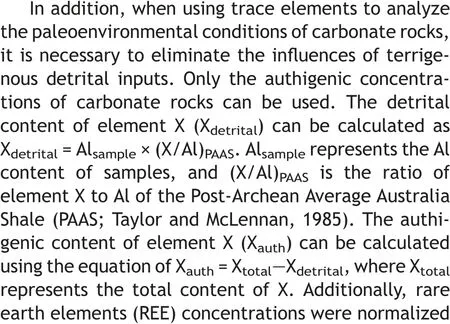

Table 1 Total organic carbon(TOC)content,stable carbon isotopes of kerogen(δ13Ckerogen),biomarkers and major element concentrations of the samples from the Ordovician Majiagou Formation in the mid-eastern Ordos Basin.
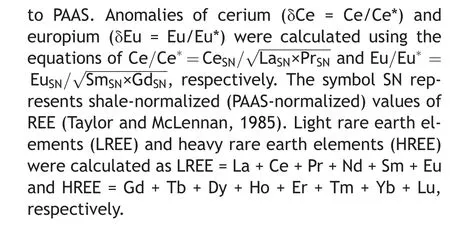
3.6.Influence of carbonate-hosted Sr,biogenic Ba and detrital Ba
Strontium (Sr) precipitates under normal marine conditions, are incorporated by carbonate minerals,where Sr can replace Ca into calcite(e.g.,Degens and Paluska,1979).The Sr/Ba ratio is a paleosalinity proxy,generally influenced by carbonate-hosted Sr(e.g.,Wei and Algeo, 2020).CaO content acts as a proxy for the carbonate content, and a significant positive relationship between Sr value and CaO content indicates the presence of carbonate-hosted Sr(Wei and Algeo,2020).As shown in Fig.3A, there is a positive relationship between CaO content and Sr value in this study.The trend(Sr=1.18×CaO+93.75)represents the influences of carbonate content on original Sr value, which were eliminated in Fig.3B.The poor relationship between CaO content and corrected Sr value is also shown in Fig.3B.In addition,the concentration of barium(Ba)is related to the primary productivity (McManus et al.,1998).Biogenic Ba (Babio) can result in low Sr/Ba ratios and erroneous paleosalinity assessments (Wei and Algeo, 2020).Babiois concentrated with organic matter sinking in the water column, which is more enriched in deep-marine deposits rather than shallowmarine platform (Franc¸ois et al., 1995; Gonneea and Paytan, 2006).The poor concentration of Babioin shallow-marine deposits limits the influence on Sr/Ba ratios (Wei and Algeo, 2020).The Babiocontent was calculated by using the equation of Babio= Batot—Ti × (Ba/Ti)PAAS(McManus et al., 1998).The(Ba/Ti)PAASratio represents the Ba/Ti ratio of PAAS(Taylor and McLennan, 1985), and Batotis the total Ba content of samples.The negative Babiovalues in this study indicate an insignificant Babioinfluence on Sr/Ba ratio.Moreover,barium in feldspar and other granitoid silicates is undissolved, and the weathering flux of barium is dominated by carbonate rocks (Dalai et al.,2002; Das and Krishnaswami, 2006).In surface waters,barium is easily adsorbed by clay minerals,which is transported into oceans with the sorbed and dissolved forms (Allmen et al., 2010).Seawater Ba is mainly from surface runoff fluxes(Coffey et al.,1997).Dissolved Ba content decreases in sea water because of the formation of BaSO4(Wolgemuth and Broecker,1970).In marine carbonates, barium mainly exists in the form of barite, related with organic-rich deposits,and detrital composition (such as feldspar) has minor contributions(Schenau et al.,2001;Tribovillard et al.,2006).In this study, the feldspar content of mud flat and mud—dolomite flat microfacies are respectively 2.4% and 1.8%, whereas the dolomite flat and open marine microfacies do not contain feldspar.Therefore,the detrital Ba content in the mud flat and mud—dolomite flat microfacies is respectively eliminated according to the proportion of feldspar in the whole rock in this study.

Fig.3 Cross plots of A)CaO content versus original Sr values and B)CaO content versus corrected Sr values of the Majiagou Formation in the mid-eastern Ordos Basin.According to the relationship between CaO content and original Sr values,the trend influenced by carbonate-hosted Sr is eliminated.
4.Results
4.1.TOC and stable carbon isotopic composition
The TOC values from different microfacies are listed in Table 1.The samples from mud flat showed the highest TOC content of 0.13 wt.%—0.59 wt.%(ave.0.32 wt.%).The TOC values of the mud—dolomite flat samples varied from 0.12 wt.% to 0.39 wt.% (ave.0.20 wt.%).The TOC content of the dolomite flat samples were comparatively low: 0.03 wt.%—0.20 wt.% (ave.0.11 wt.%).The open marine samples were characterized by low TOC content of 0.02 wt.%—0.09 wt.% (ave.0.06 wt.%) (Table 1).In addition, the stable carbon isotopic compositions of kerogen (δ13Ckerogen, ‰) of the Majiagou Formation were shown in Table 1.The δ13Ckerogenvalues of mud flat samples range from -27.8 ‰ to -26.5 ‰ (ave.-27.3 ‰), and the mud—dolomite flat samples showed δ13Ckerogenvalues varying between -29.0 ‰and-26.5‰(ave.-27.8‰).The δ13Ckerogenvalues of dolomite flat samples varied from-27.3‰to-27.1‰(ave.-27.2‰),and the open marine samples had the δ13Ckerogenvalues ranging from -30.4 ‰ to -27.9 ‰,with an average of -29.2 ‰.
4.2.Steroids and terpenoids
The steroid and terpenoid biomarkers are shown in m/z=217 and m/z=191 mass chromatograms(Fig.4).The C27—C28—C29regular steranes are characterized by C27> C29> C28distributions (Fig.4).The relative abundance of the C27—C28—C29regular steranes in the mud flat samples ranged in 44%—49%(ave.47%),23%—28% (ave.26 %), and 26%—27% (ave.27 %), respectively.The relative abundance of C27—C28—C29regular steranes in the mud—dolomite flat samples was 41%—47% (ave.45%), 24%—31% (ave.27%), and 26%—30%(ave.28%), respectively.The relative abundance of C27—C28—C29regular steranes of dolomite flat samples was 41%—43%, 27%—28%, and 31%, respectively.The relative abundance of C27—C28—C29regular steranes of the open marine samples was 45%—49% (ave.46%),25%—26% (ave.25%), and 25%—30% (ave.28%),respectively (Table 1).
The highest regular sterane/C30hopane values were found in the mud flat samples,varying from 1.49 to 1.55 (ave.1.51).The regular sterane/C30hopane ratio of mud—dolomite flat samples ranged from 1.21 to 1.55, with an average of 1.35.The samples of dolomite flat had regular sterane/C30hopane ratio of 1.09—1.10 (ave.1.09), and the open marine samples yielded regular sterane/C30hopane ratio of 1.08—1.29(ave.1.20)(Table 1).The tricyclic terpane/C30hopane(TT/C30H)values of mud flat samples were 1.50—1.84(ave.1.63).The TT/C30H values of mud—dolomite flat samples varied from 1.22 to 2.34, with an average of 1.82.The TT/C30H values of dolomite flat samples was 0.58—0.62 (ave.0.60), and of open marine samples were 0.88—1.27 (ave.1.04)(Table 1).
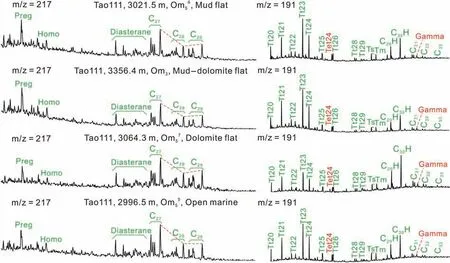
Fig.4 Gas chromatography—mass spectrometry (GC—MS) showing the steroids and terpenoids characteristics of samples from mud flat,mud—dolomite flat, dolomite flat and open marine microfacies in the Majiagou Formation in the mid-eastern Ordos Basin.
4.3.Major elements
The major element content of the Majiagou Formation is shown in Table 1.The major oxides found in the samples were SiO2, Al2O3, MgO, and CaO, and different microfacies exhibited different compositions of major elements.The mud flat microfacies was composed primarily of SiO2(27.65%—53.32%; ave.39.16%)and Al2O3(9.28%—20.28%;ave.13.64%),with a lower proportion of CaO (3.02%—18.56%; ave.11.55%) and MgO (3.07%—9.68%; ave.7.53%).The samples of mud—dolomite flat microfacies were characterized by relatively high SiO2and CaO content, varying from 12.34% to 33.97% (ave.24.44%),and from 13.23% to 40.55% (ave.23.23%), respectively.They had relatively low content of MgO and Al2O3, respectively ranging from 2.18% to 13.39%(ave.9.15%) and from 4.57% to 10.63% (ave.7.24%).The dolomite flat microfacies samples showed high content of CaO (30.44%—33.19%; ave.31.17%) and MgO (18.51%—20.90%; ave.20.19%), and low SiO2(0.95%—1.66%; ave.1.36%) and Al2O3(0.21%—0.62%;ave.0.35%) values.The open marine microfacies samples were characterized by high CaO content(46.70%—54.74%;ave.51.47%),and low values of MgO(0.40%—6.47%; ave.3.06%), SiO2(0.33%—3.20%; ave.1.56%)and Al2O3(0.17%—0.71%;ave.0.34%)(Table 1).The concentration of the trace compound TiO2was also measured,which indicated that the mud flat and mud—dolomite flat samples were of relatively high values of TiO2, varying from 0.46% to 1.01% (ave.0.65%) and from 0.16% to 0.40% (ave.0.30%) respectively.In contrast, the TiO2content of the dolomite flat and open marine samples were 0.01%—0.02%(ave.0.01%) and 0.01%—0.03% (ave.0.01%), respectively(Table 1).
The authigenic marine origin phosphorus (Pauth)and the detrital fraction of phosphorus from terrigenous detrital inputs (Pdetrital) were calculated in this study.The mud flat microfacies samples had the highest content of Pauthand Pdetrial, ranging from 102.95 ppm to 179.87 ppm (ave.142.65 ppm), and from 343.79 ppm to 512.34 ppm (ave.423.19 ppm),respectively(Table 1).The values of Pauthand Pdetrialin the mud—dolomite flat samples were also relatively high, from 42.30 ppm to 209.38 ppm (ave.104.67 ppm), and from 169.30 ppm to 344.90 ppm(ave.260.80 ppm) respectively (Table 1).In contrast,comparatively low Pauthand Pdetrialvalues were obtained from the dolomite flat and open marine microfacies samples.The Pauthand Pdetrialcontent of the dolomite flat microfacies samples were respectively 7.50 ppm—43.69 ppm (ave.24.26 ppm) and 7.74 ppm—23.04 ppm (ave.13.03 ppm).The open marine microfacies samples showed low Pauthand Pdetrialcontent varying from 4.14 ppm to 36.63 ppm(ave.20.70 ppm) and from 6.41 ppm to 26.27 ppm(ave.12.76 ppm), respectively (Table 1).
4.4.Trace and rare earth elements
The measured amounts of trace and rare earth elements, as well as the calculated elemental ratios in the Majiagou Formation, are shown in Table 2.The mud flat microfacies samples showed the highest level of trace and rare earth elements: Th of 14.50 ppm—34.80 ppm (ave.19.98 ppm); Zr of 83.90 ppm—158.00 ppm (ave.111.80 ppm); Uauthof 6.33 ppm—17.87 ppm(ave.12.09 ppm);Moauthof 2.88 ppm—4.81 ppm (ave.3.61 ppm); Crauthof 3.94 ppm—19.33 ppm (ave.12.11 ppm); and Coauthof 2.50 ppm—9.61 ppm(ave.4.90 ppm).In the case of the mud—dolomite flat microfacies samples, all of the measured values of trace and rare earth elements were comparatively lower:Th of 4.70 ppm—10.50 ppm(ave.7.24 ppm); Zr of 25.60 ppm—63.60 ppm (ave.42.41 ppm); Uauthof 0.69 ppm—8.48 ppm (ave.2.79 ppm); Moauthof 0.09 ppm—3.51 ppm (ave.1.30 ppm); Crauthof 1.25 ppm—15.40 ppm (ave.7.86 ppm); and Coauthof 0.47 ppm—3.00 ppm (ave.1.71 ppm).The dolomite and open marine microfacies samples were found to have low content of Th, Zr,Uauth,Moauth,Crauth,and Coauth(Table 2).The dolomite flat samples were characterized by low Th, Zr, Uauth,Moauth,Crauth,Coauthcontent ranging from 0.19 ppm to 0.63 ppm (ave.0.37 ppm), 1.09 ppm—2.80 ppm (ave.1.93 ppm), 0.24 ppm—3.32 ppm (ave.0.85 ppm),0.15 ppm—1.31 ppm (ave.0.45 ppm),2.40 ppm—9.45 ppm (ave.5.79 ppm) and 1.09 ppm—2.53 ppm (ave.1.82 ppm), respectively.The Th, Zr, Uauth, Moauth, Crauth, Coauthcontent of the open marine microfacies samples were respectively 0.24 ppm—1.46 ppm (ave.0.51 ppm),1.28 ppm—11.60 ppm (ave.3.12 ppm), 0.32ppm—1.65 ppm (ave.0.57 ppm), 0.08 ppm—0.39 ppm(ave.0.26 ppm),0.50 ppm—8.83 ppm(ave.4.72 ppm),and 1.45 ppm—2.42 ppm (ave.2.02 ppm) (Table 2).

Table 2 Trace and rare earth elements of the samples from the Ordovician Majiagou Formation in the mid-eastern Ordos Basin.
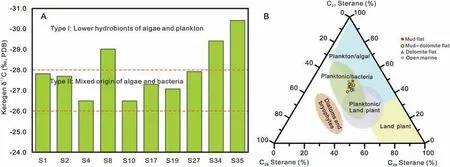
Fig.5 A) Histogram of δ13C values of kerogens and B) Ternary plot of C27, C28, and C29 steranes of samples (after Huang and Meinschein,1979) from the Majiagou Formation in the mid-eastern Ordos Basin.The organic matter in the Majiagou Formation has a mixed origin of algae and bacteria.
In addition, the mud flat samples yielded the highest ΣREE content (total REE)(133.80 ppm—221.85 ppm;ave.174.63 ppm),followed by the mud—dolomite flat samples(36.59 ppm—124.38 ppm; ave.84.52 ppm).In contrast, the dolomite flat and open marine microfacies samples showed very low ΣREE content, varying between 2.30 ppm and 9.84 ppm (ave.5.88 ppm)and 4.09 ppm—15.87 ppm (ave.8.71 ppm), respectively(Table 2).The LREE/HREE values of different microfacies were: 12.34—16.07 (mud flat microfacies, ave.14.13), 7.01—11.82 (mud—dolomite flat microfacies,ave.9.96), 5.16—12.28 (dolomite flat microfacies,ave.8.33),and 7.80—13.11(open marine microfacies,ave.9.66).The (La/Yb)PAASvalues of mud flat microfacies samples were 1.40—2.38(ave.1.74),(La/Yb)PAASvalues of mud—dolomite flat microfacies samples were 0.63—1.37 (ave.1.09), values of dolomite flat microfacies samples were 0.43—1.98 (ave.0.98), and those of open marine microfacies samples were 0.73—1.89(ave.1.28)(Table 2).The δCe values of mud flat microfacies samples were 0.86—0.82 (ave.0.91),δCe values of mud—dolomite flat microfacies samples were 0.91—1.16 (ave.1.02), values of dolomite flat microfacies samples were 0.93—1.05 (ave.0.99), and those of open marine microfacies samples were 0.93—1.05 (ave.1.00).Lastly, the δEu values of mud flat microfacies samples were 0.67—0.88 (ave.0.79),δEu values of mud—dolomite flat microfacies samples were 0.84—1.44 (ave.1.04), values of dolomite flat microfacies samples were 0.74—1.38 (ave.1.07), and the δEu values of open marine microfacies samples were 0.83—1.36 (ave.1.06)(Table 2).
5.Discussion
5.1.Source rock characterization and biological source of the organic matter
5.1.1.Analysis of stable carbon isotopes and biomarkers
Stable carbon isotopic (δ13C) values are commonly used to determine the type and origin of organic matter (e.g., Golyshev et al., 1991; Jarvie et al.,2007).The δ13C of kerogens originating from lower hydrobionts of algae and plankton has been reported to range from -32.0 ‰ to -28.0 ‰ (Golyshev et al.,1991).The average δ13C value of kerogens from the Majiagou Formation is -28.1 ‰, indicating type I to type II organic matter (Fig.5A).Because terrigenous plants became widely distributed during the Devonian,the level of δ13C of kerogens found in this study is the evidence of biogenetic derivation of organic matter chiefly from lower marine algae and plankton and,to a lesser extent,bacterial organisms.
Steranes are derived from precursor sterols,which are detected in all eukaryotes (e.g., algae and higher plants)(Huang and Meinschein,1979).Algae were the main producers of steranes during the Paleozoic within marine depositional environments, in contrast with the higher-plant-derived contributions before the Devonian (Alkhafaji et al., 2015).In addition, C27steranes are mainly derived from algae, and C28steranes may be associated with phytoplankton groups(Huang and Meinschein,1979).As shown in the ternary plot(Fig.5B),the results from our samples were within the range of the planktonic/bacterial zone.On the terpane fragmentograms (m/z = 191), the abundance of tricyclic terpanes was much higher than that of pentacyclic triterpanes (Fig.4).The presence of pentacyclic terpanes is indicative of an additional bacterial contribution to the organic matter (Alkhafaji et al., 2015).The presence of hopanes can be used as a molecular evidence to verify the bacterial inputs(Fig.4) (Peters et al., 2005; Pehr et al., 2018).The relatively high concentration of tricyclic terpanes suggests a possible origin of Tasmanites (Aquino Neto et al., 1992) or Leiosphaeridia prasinophyte algae(Dutta et al., 2006; Alkhafaji et al., 2015) (Fig.4).Therefore,we can conclude that the organic matter in the Majiagou Formation is mainly derived from planktonic algae, followed by bacteria.
5.1.2.Planktonic algae and bacteria fossils under SEM
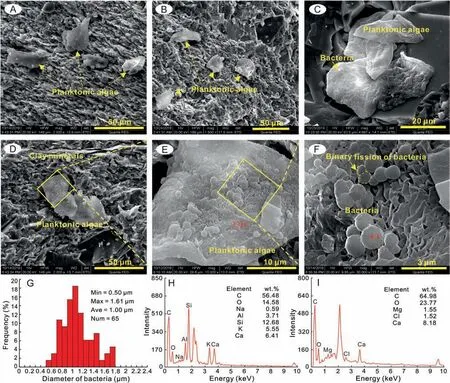
Fig.6 SEM photographs of planktonic algae (A—C)and bacteria fossils (D—F); (G)Histogram of bacterial fossil diameters;energy spectrum analysis results of planktonic algae (H) and bacteria fossils (I) identified in the samples of the Majiagou Formation in the mid-eastern Ordos Basin (A: S1, Tao111, 3021.5 m, mud flat; B: S2, Tao111, 3023.5 m, mud flat; C, H: S13, Tao61, 4065.1 m, mud—dolomite flat; D—G, I: S12,Tao61,4060.8 m,mud—dolomite flat).Planktonic algae fossils are chip-shaped with organic carbon content of 56.48 wt.%,and bacteria fossils have a diameter of approximately 1 μm with organic carbon values of 64.98 wt.%.
Scanning electron microscope (SEM) has been frequently used to identify and describe microfossils(Bailey et al., 2007).In the samples of the Majiagou Formation,the microfossils(diameter:20 μm—40 μm)were found to be embedded in the minerals, and the surface ornamentation was flattened because of late diagenetic compaction (Fig.6A—C).Fossils of such small scale are often destroyed by poor preparation of core samples or as a result of contamination with modern soil (Perri and Tucker, 2007).However, in the present study, the microfossils were found to be intact.In general, algae can be divided into benthic and planktonic groups according to their lifestyle(Fott, 1981; Liu, 1990).The main hydrocarbongenerating organisms in the Lower Paleozoic marine source rocks are both planktonic and benthic algae(Tenger,2011;Liu et al.,2017).The morphology of the microfossils is indicative of the type of algae; chipshaped microfossils are generally planktonic algae(Fig.6A—F).The results of the energy spectrum analysis showed that the microfossils had a high concentration of carbon (56.48 wt.%) (Fig.6H).Thus, the planktonic algae in the samples were likely enriched in organic carbon.
Spherical microfossils were also identified under SEM(Fig.6E and F),varying in size as a result of stage of division, with an average diameter of 1.00 μm(diameter: 0.50 μm—1.61 μm) (Fig.6G).Two-cell clusters are the result of binary fission, whereas three-cell clusters likely result from the incomplete division of a two-cell cluster (Bailey et al., 2007)(Fig.6F).The geometry and dimension of the spheroidal microfossils are similar to modern bacteria in microbial mat communities (Vasconcelos et al., 2006;Perri and Tucker, 2007).The bacteria fossils had a higher concentration of carbon (64.98 wt.%) (Fig.6I).Taking these results together, the biological source of organic matter in the carbonate source rocks of the Ordovician Majiagou Formation is chiefly planktonic algae, followed by bacteria.
5.2.Reconstruction of depositional environment
5.2.1.Detrital input and sedimentation rate
The observations of core and thin section photographs indicate that mud flat and mud—dolomite flat microfacies have more terrigenous detrital inputs compared with dolomite flat and open marine microfacies (Fig.7).Clay minerals are derived from terrestrial detrital inputs, and the samples from the mud flat and mud—dolomite flat microfacies were found to have higher concentrations of clay minerals of 18.5% and 11.0% respectively, compared with the dolomite flat and open marine microfacies samples,based on the XRD results (Fig.7).
In addition, aluminum exists within clay minerals,and titanium is generally associated with clay and several specific minerals(ilmenite,rutile,sphene,and augite) (Yan et al., 2015).Ti and Al are typically derived from terrestrial detrital sources.In our analyses on the samples of microfossils,we found a strong positive relationship between Al2O3and TiO2content,indicating that the Ti present in the samples is primarily derived from terrestrial detrital sources(Fig.8A).Previous studies have shown that Si, Zr, and Th indicate detrital fluxes (Murphy et al., 2000;Tribovillard et al.,2006).The Th and Zr values obtained in this study indicate a strong positive correlation with the Al2O3content (Fig.8B and C).The samples from mud flat and mud—dolomite flat microfacies exhibited higher Al2O3,TiO2,Th,and Zr values than samples from dolomite flat and open marine microfacies,indicating a high abundance of terrigenous detrital inputs(Fig.8A—D).Moreover,the TOC content of the mud flat and mud—dolomite flat microfacies samples were much higher than corresponding values obtained from dolomite flat and open marine microfacies (Fig.8E).Terrigenous detrital inputs generally increase the abundance of clay minerals, resulting in a higher adsorption capacity and organic matter accumulation.Phosphorus, considered as an essential nutrient(Dymond et al., 1992; Dymond and Collier, 1996), is also indicative of biological sources.Pdetrial, representing the detrital fraction of the element P from terrigenous detrital inputs, was found to be considerably higher in the mud flat (ave: 505.2 ppm) and mud—dolomite flat samples (ave: 268.3 ppm) than in the dolomite flat (ave: 13.0 ppm) and open marine samples(ave:12.8 ppm)(Fig.8F).The results indicate a positive correlation between Pdetrialand TOC content(Fig.8F); thus, increased terrigenous detrital inputs could have also enhanced the nutrient input facilitating biotic productivity and organic matter accumulation.
The degree of differentiation of rare earth elements(REE)can reflect the sedimentation rate(Wang et al.,1989).With a relatively low sedimentation rate,there is sufficient time for REE to be absorbed by finegrained sediments, resulting in strong differentiation of REE (Wang et al., 1989).Moreover, fine-grained sediments in water not only adsorb REE but are also the main carriers of absorbed organic matter.In the PAAS-normalized REE distribution patterns of this study (Taylor and McLennan, 1985), the mud flat and mud—dolomite flat microfacies samples were found to have obvious concentration of LREE, compared with dolomite flat and open marine microfacies samples(Fig.9).In particular,the mud flat samples had higher LREE/HREE and (La/Yb)PAASratios (14.13 and 1.74,respectively) than did the samples of the other three types of microfacies(Table 2).The sedimentation rate of the mud flat and mud—dolomite flat microfacies was lower than that of the dolomite and open marine microfacies material.Lastly, TOC content was higher and the sedimentation rate was lower in the mud flat and mud—dolomite flat samples, compared with the values obtained from the dolomite flat and open marine microfacies samples.
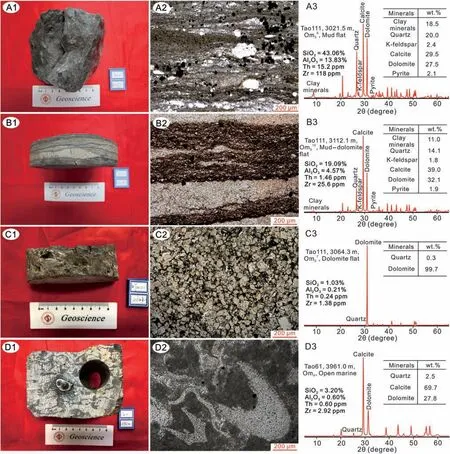
Fig.7 Photographs of core and thin section observation under transmission light and X-ray diffraction results of samples in the mud flat microfacies (A1—A3), mud—dolomite flat microfacies (B1—B3), dolomite flat microfacies (C1—C3) and open marine microfacies (D1—D3).The mud flat and mud—dolomite flat microfacies have relatively high terrigenous detrital minerals compared with the dolomite flat and open marine microfacies of the Majiagou Formation in the mid-eastern Ordos Basin.
5.2.2.Paleoclimate

Fig.8 A—D) Cross plots of the relationship among Al2O3, TiO2, Th and Zr values showing that mud flat and mud—dolomite flat microfacies have significantly high terrigenous detrital inputs compared with dolomite flat and open marine microfacies;E—F)The relationship of Th and Pdetrital versus TOC content indicating that high detrital inputs promote nutrient level and organic matter accumulation of the Ordovician Majiagou Formation in the mid-eastern Ordos Basin.
As mentioned above,the mud flat microfacies was found to have the largest input of terrestrial detritus,likely carried by the surface runoff in relatively warm and humid climate, and followed by the mud—dolomite flat microfacies (Fu et al., 2018).The dolomite flat and open marine microfacies were possibly formed under conditions of lower terrestrial detrital inputs, given the hot and arid climate.These conclusions are also supported by thin-section observations and the X-ray diffraction results (Fig.7).In addition, the strontium (Sr)/copper (Cu) ratio,commonly used to evaluate paleoclimate (Lerman,1978, 1989), was informative in the case of the samples from Majiagou Formation.The main sink of Sr in the ocean is substitution of Sr2+for Ca2+in carbonate minerals (Roden et al., 2002).The influence of carbonate-host Sr on the Sr/Cu ratio was eliminated in this study(Fig.3).In addition,due to the influence of diagenetic fluids, carbonate rocks are often characterized by increasing Mn content and decreasing Sr content; thus, the Mn/Sr ratio of carbonate rocks can be used to determine the degree of alteration(Kaufman and Knoll, 1995).In the present study, the average value of Mn/Sr in the mud flat,mud—dolomite flat, dolomite flat, and open marine microfacies samples was 0.56, 0.86, 1.11, and 0.39, respectively.Values of<2.0 indicate the low degree of diagenesis of carbonate rocks (Kaufman and Knoll, 1995; Chen et al., 2015).Therefore, eliminating carbonatehosted Sr, Sr/Cu values in the samples of the Majiagou Formation can reflect paleoclimate condition to some extent.Generally, Sr/Cu less than 10 indicates warm and humid climate,whereas Sr/Cu more than 10 reveals hot and arid climate(Lerman,1989).The mud flat and mud—dolomite flat microfacies samples respectively had an average Sr/Cu of 3.59 and 8.07,indicating warm and humid climate.In contrast,samples from the dolomite flat and open marine microfacies were found to have average Sr/Cu values of 65.06 and 139.97, revealing hot and arid climate(Fig.10A).Moreover, high Rb/Sr values represent warm and humid climate, whereas low Rb/Sr values indicate hot and arid climate(Lerman,1978,1989;Jia et al., 2013).Our analysis uncovered a significant negative correlation between the Sr/Cu and Rb/Sr ratios(Fig.10A).The mud flat and mud—dolomite flat microfacies samples yielded high Rb/Sr and low Sr/Cu ratios,indicative of warm and humid climate,and the dolomite flat and open marine microfacies samples had low Rb/Sr and high Sr/Cu ratios,indicating hot and arid climate (Fig.10A).We also found a negative relationship between Sr/Cu ratio and TOC content(Fig.10B).The mud flat and mud—dolomite flat samples were characterized by relatively high Rb/Sr ratio,low Sr/Cu ratio,and high TOC content,all indicative of warm and humid climate (Fig.10A and B).In comparison,the dolomite flat and open marine samples were found to have low Rb/Sr ratio, high Sr/Cu ratio, and low TOC content,which points to hot and arid climate(Fig.10A and B).Together, these results indicate that warm and humid climate are favorable for organic matter accumulation in source rocks.
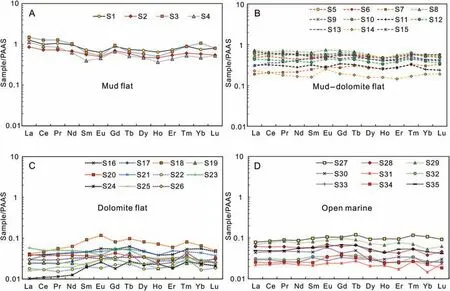
Fig.9 REE concentrations of the samples from A) the mud flat microfacies, B) the mud—dolomite flat microfacies, C) the dolomite flat microfacies, D) the open marine microfacies, normalized to PAAS (Taylor and McLennan, 1985).The normalized patterns of mud flat and mud—dolomite flat microfacies samples show LREE enrichment compared with the dolomite flat and open marine microfacies samples in the Majiagou Formation in the mid-eastern Ordos Basin.
5.2.3.Paleoproductivity
Paleoproductivity is related to levels of carbon and phosphorus (Murray and Leinen, 1993; Schmitz et al.,1997; Tyrrell, 1999).In general, the TOC content is expected to be less than the initial value because of burial, thermal maturation, hydrocarbon generation,and expulsion, but still serves as an indicator of photosynthetic primary productivity (Li et al., 2020).The mud flat and mud—dolomite flat microfacies samples showed respectively higher average TOC content of 0.32 wt.% and 0.20 wt.%, whereas the dolomite flat and open marine microfacies samples had relatively lower average TOC content of 0.11 wt.%and 0.06 wt.% (Table 1; Fig.11).The TOC results indicate that the mud flat and mud—dolomite flat microfacies have relatively high paleoproductivity.

Fig.10 Cross plot of Sr/Cu ratio versus A)Rb/Sr ratio and B)TOC content from the samples from four types of microfacies of the Majiagou Formation in the mid-eastern Ordos Basin.The mud flat and mud—dolomite flat microfacies were mainly formed in the warm and humid climate with relatively high TOC content.
In addition, phosphorus is considered as an essential nutrient and can indicate biological productivity in aquatic systems (Dymond et al., 1992; Dymond and Collier, 1996; Schmitz et al., 1997; Tyrrell, 1999;Algeo et al., 2011).Because only authigenic marine origin of phosphorus (Pauth) can be used to reflect productivity, the effect of terrigenous detrital inputs on P content should be eliminated.The mud flat and mud—dolomite flat microfacies samples showed average Pauthvalues of 142.65 ppm and 104.67 ppm,respectively; whereas the dolomite flat and open marine microfacies samples respectively exhibited average Pauthvalues of 24.26 ppm and 20.70 ppm.Samples of four microfacies had an average Pdetritalvalue of 423.19 ppm, 260.80 ppm, 13.03 ppm, and 12.76 ppm,respectively(Fig.12A).Pdetritalvalues have a greater contribution to paleoproductivity than Pauthvalues in the mud flat and mud—dolomite flat microfacies, whereas the contribution of Pauthvalues are higher than Pdetritalvalues in the dolomite flat and open marine microfacies (Fig.12A and B).The terrigenous detrital inputs could have increased the level of nutrient phosphorus to facilitate the paleoproductivity.Both mud flat and mud—dolomite flat microfacies samples were found to have relatively high nutrient levels and primary productivity,compared to the dolomite flat and open marine microfacies material.
In addition, the mud flat and mud—dolomite flat microfacies samples were determined to have high regular sterane/C30hopane ratio of 1.51 and 1.35,whereas the dolomite flat and open marine microfacies samples yielded low regular sterane/C30hopane ratio of 1.09 and 1.20, respectively (Table 1).The relatively high abundance of tricyclic terpanes (TT) is possibly due to an algal origin(Dutta et al.,2006).The TT/C30hopane ratio of the mud flat and mud—dolomite flat materials varied from 5.35 to 6.14(ave.5.59) and from 3.87 to 6.51 (ave.5.82), which are higher than those ratios obtained from the dolomite flat (ave.2.11) and open marine (ave.3.63)microfacies samples (Fig.12C and D).Moreover, the SEM observations show that the mud flat and mud—dolomite flat microfacies contain more planktonic algae microfossils than the dolomite flat and open marine microfacies.These results indicate that the mud flat and mud—dolomite flat microfacies in the Majiagou Formation have higher paleoproductivity than the dolomite flat and open marine microfacies.
5.2.4.Paleosalinity and paleoredox conditions

Fig.11 Box diagrams of TOC content of mud flat, mud—dolomite flat, dolomite flat and open marine microfacies samples of the Majiagou Formation in the mid-eastern Ordos Basin, showing that TOC content have a decreasing trend from mud flat to open marine microfacies.
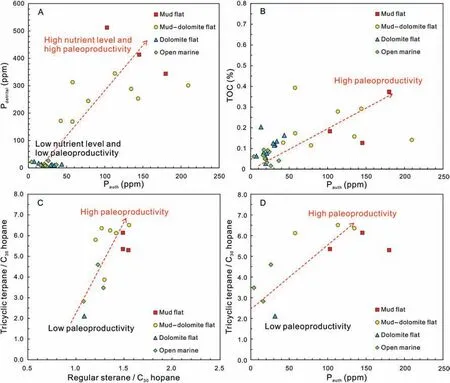
Fig.12 Cross plots of A) Pauth value versus Pdetrital value, B) Pauth value versus TOC content, C) Regular sterane/C30 hopane ratio versus tricyclic terpanes/C30 hopane ratio,D)Pauth value versus tricyclic terpanes/C30 hopane ratio,indicating the higher nutrient level and higher paleoproductivity in the mud flat and mud—dolomite flat microfacies than in the dolomite flat and open marine microfacies of the Majiagou Formation in the mid-eastern Ordos Basin.

Fig.13 A)Cross plot of Sr/Ba versus TOC values showing a negative correlation between the salinity and the TOC content;B—C)Cross plots showing the relationship between Uauth content and Moauth content and the relationship between Uauth content and TOC content, indicating that the mud flat microfacies was formed in a relatively reducing environment with high TOC content compared with other three microfacies of the Majiagou Formation in the mid-eastern Ordos Basin.
The samples with low Mn/Sr ratio of the carbonate rocks from the Majiagou Formation are characterized by a low degree of diagenesis and alteration(Kaufman and Knoll,1995).Elemental Sr is mainly autochthonous marine origin, which can reflect paleoenvironmental condition.Strontium(Sr)and barium(Ba)have similar chemical properties and can generate soluble bicarbonate, oxide, and sulfate, which are considered the evidence of paleosalinity (Degens and Paluska, 1979).Moreover, strontium, having a higher migration capacity than barium, can precipitate under normal marine environments, and carbonate minerals can incorporate strontium (Degens and Paluska, 1979).In general,a low Sr/Ba value(<0.6)reflects fresh water,a moderate Sr/Ba value (0.6—1.0) indicates brackish water, and a high Sr/Ba value (>1.0) reflects saline water(Wang,1996;Luo and Wang,2010).The mud flat microfacies samples had Sr/Ba ratio of 0.54—0.68 with an average of 0.60,indicating fresh to brackish water.The Sr/Ba ratio of the mud—dolomite flat samples varied from 0.37 to 3.56 (ave.1.04), reflecting saline water.The Sr/Ba ratio of dolomite flat and open marine microfacies samples ranged from 2.76 to 16.64(ave.7.58) and from 4.54 to 35.26 (ave.18.33)respectively, indicating relatively higher degree of salinity (Fig.13A).Redox conditions are important to evaluate the accumulation and preservation of organic matter(Degens and Paluska,1979;Lyons et al.,2009).Molybdenum(Mo)and uranium(U)show high solubility under oxic conditions, and high uranium enrichments indicate oxygen-deficient bottom water (Algeo and Maynard, 2004; Tribovillard et al., 2006).Only authigenic content of redox-sensitive elements can be used to reconstruct the paleoenvironment (Tribovillard et al., 2006).Wignall and Myers (1988) proposed the authigenic uranium (Uauth) content as an index of bottom water anoxia in ancient sedimentation.In general, a low Uauthconcentration (<5 ppm) indicates oxic to dysoxic conditions, whereas a high Uauthconcentration (>12.0 ppm) reveals suboxic and anoxic conditions (Jones and Manning, 1994).The mud flat microfacies samples had the highest Uauthvalue (ave.12.09 ppm), indicating the suboxic and anoxic condition.The mud—dolomite flat, dolomite flat, and open marine microfacies samples had relatively low Uauthconcentrations with an average of 2.79 ppm,0.85 ppm, and 0.57 ppm, respectively, reflecting dysoxic to oxic conditions (Fig.13B).The mud flat microfacies samples had Moauthconcentrations of 2.88 ppm—4.81 ppm (ave.3.61 ppm), which were higher than the corresponding values measured in the mud—dolomite flat (ave.1.30 ppm), dolomite flat(ave.0.45 ppm), and open marine (ave.0.26 ppm)microfacies samples (Fig.13B).Chromium (Cr) and cobalt (Co) are also redox-sensitive trace elements(Cranston and Murray, 1978; Achterberg et al., 2003).In oxic environments,both Cr (Cr4+)and Co(Co2+) are present as dissolved cations (Calvert and Pedersen,1993; Achterberg et al., 2003) and can be precipitated as insoluble Cr compounds (e.g., Cr(OH)3or Cr2O3) and insoluble sulfide (e.g., CoS) respectively under anoxic condition (Elderfield, 1970; Huerta-Diaz and Morse, 1992).The mud flat microfacies samples were found to have an average Crauthvalue of 12.11 ppm and an average Coauthvalue of 4.90 ppm,both higher than the average values of samples from the mud—dolomite flat (7.86 ppm and 1.71 ppm),dolomite flat (5.79 ppm and 1.82 ppm), and open marine(4.58 ppm and 2.02 ppm)microfacies(Table 2).In addition,many previous studies have shown that the redox conditions have an obvious controlling effect on cerium geochemistry of the marine sedimentary environment (Elderfield and Greaves, 1982; Zhang and Shields, 2022).Cerium (Ce) is less affected by terrigenous silicate minerals (Elderfield, 1988).Marine authigenic minerals are considered to record the original signal of seawater, and Ce anomalies from carbonate authigenic minerals can reflect bottom water conditions (Lawrence et al., 2006).In general,insoluble Ce4+is reduced to soluble Ce3+under anoxic conditions, and the Ce negative anomaly can be recorded in sediments (Lawrence et al., 2006).Thus,the low δCe value (<1) indicates a suboxic and anoxic condition,whereas high δCe value(>1)reflects an oxic to dysoxic condition(Lawrence et al.,2006).The mud flat samples in the present study had δCe values of 0.86—0.92 with an average of 0.91, whereas the mud—dolomite flat, dolomite flat, and open marine microfacies samples showed Ce positive anomalies(δCe>1).Moreover,δEu values of the mud flat samples varied from 0.67 to 0.88 (ave.0.78), in contrast with the mud—dolomite flat, dolomite flat, and open marine samples, with average δEu values of 1.04, 1.07,and 1.06, respectively (Table 2).Thus, the mud flat microfacies was formed in suboxic and anoxic conditions with high TOC content, whereas the mud—dolomite flat, dolomite flat, and open marine microfacies were formed in dysoxic to oxic conditions with relatively low TOC content (Fig.13C).
5.3.Organic matter enrichment model in the Majiagou Formation
The results of correlation analysis between the TOC content and the paleoenvironmental indices are shown in Table 3.These relationships reflect that the enrichment of organic matter is controlled by multiple factors.The high positive correlations were observed among Al2O3(correlation coefficient = 0.73), TiO2(correlation coefficient = 0.74), Th (correlation coefficient = 0.77), Zr (correlation coefficient = 0.71)relative to the TOC content (Table 3).The results indicate that the main factor of organic matter concentration is terrigenous detrital inputs.In addition,the content of Uauth, Moauth, and Moauthis highly positively correlated with the TOC content by the correlation coefficient of 0.68, 0.65, and 0.73 respectively(Table 3).There is a highly positive relationship between the Pauthand TOC values with a correlation Ordovician Majiagou Formation in the mid-eastern Ordos Basin.coefficient of 0.59, and a high positive relationship between the Pdetritaland TOC values with a correlation coefficient of 0.58(Table 3).Thus,redox condition and paleoproductivity are important factors promoting organic matter enrichment.Moreover,the correlation coefficients between Rb/Sr and TOC, between Sr/Cu and TOC, between Sr/Ba and TOC, between LREE/HREE and TOC were relatively insignificant, which suggests that the paleoclimate, paleosalinity, and sedimentation rate are relatively unimportant factors.
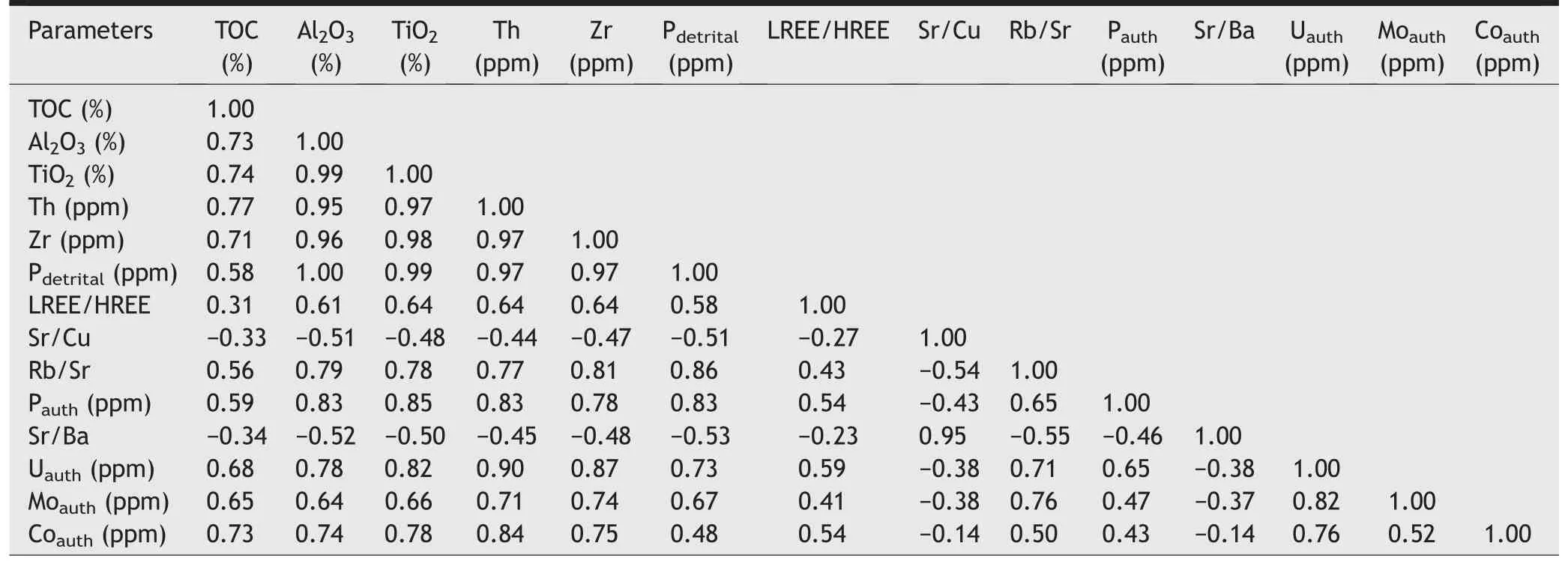
Table 3 Correlation analysis of total organic carbon(TOC)content and depositional environment parameters of the samples from the
In this study,a model of organic matter enrichment in the Majiagou Formation was established (Fig.14).Under warm and humid climate, the mud flat and mud—dolomite flat microfacies were formed under the condition of abundant terrestrial detrital inputs brought by surface runoff, enhancing nutrient Pdetritalcontent (Figs.12A and 14A).High terrigenous detrital inputs increased the abundance of clay minerals and led to a high adsorption capacity for organic matter accumulation.Moreover, abundant surface runoff reduced water salinity, generating fresh to brackish environments.More nutrient elements (e.g., Pdetrital,Pauth)facilitate biotic productivity supported by lots of microfossils of planktonic algae in the mud flat and mud—dolomite flat microfacies (Fig.6A—F).Planktonic algae reduced the dissolved oxygen in the water.The suboxic and anoxic environments promoted the preservation of organic matter in the mud flat and mud—dolomite flat microfacies (Fig.14A).Both the mud flat and mud—dolomite flat microfacies had relatively high TOC content,making them both having potentials as source rocks in the Majiagou Formation.In contrast, the dolomite flat and open marine microfacies were shown to have relatively low terrestrial detrital inputs under hot and arid climate,resulting in low levels of nutrient elements and low paleoproductivity.The dysoxic to oxic conditions in the dolomite flat microfacies and open marine microfacies were not conducive to the preservation of organic matter (Fig.14B).Therefore, the mud flat and mud—dolomite flat microfacies are most suitable for organic matter enrichment in the Majiagou Formation.
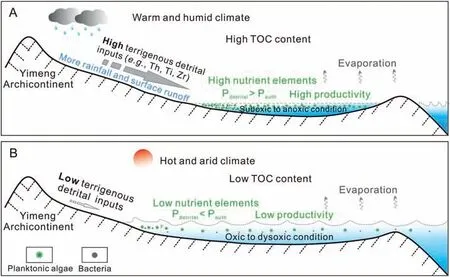
Fig.14 Organic matter accumulation models of A) the mud flat and mud—dolomite flat microfacies, and, B) the dolomite flat and open marine microfacies of the Ordovician Majiagou Formation in the mid-eastern Ordos Basin.
6.Conclusions
The Majiagou Formation consists of four types of microfacies: mud flat, mud—dolomite flat, dolomite flat,and open marine.The mud flat and mud—dolomite flat microfacies show high TOC content, indicative of the development of source rocks.The biological sources of organic matter of the Majiagou Formation are mainly planktonic algae and bacteria,as evidenced by measurements of δ13C values and the presence of biomarkers and mircofossils identified under SEM.
The high Al2O3,TiO2,Th,and Zr values in mud flat and mud—dolomite flat microfacies indicate a higher abundance of terrigenous detrital inputs than in the dolomite flat and open marine microfacies.The mud flat and mud—dolomite flat were formed under a relatively low sedimentation rate compared with the conditions of the dolomite flat and open marine microfacies.The mud flat and mud—dolomite flat sediments were deposited in warm and humid paleoclimate, whereas the dolomite flat and open marine sediments occurred in hot and arid paleoclimate, as indicated by Sr/Cu and Rb/Sr values.The mud flat and mud—dolomite flat microfacies have relatively high paleoproductivity, as indicated by high TOC and Pauthcontent, and planktonic algae fossils.The low Sr/Ba values found in the mud flat samples are indicative of fresh to brackish water, whereas saline water is more likely to have been present in the mud—dolomite flat,dolomite flat, and open marine microfacies.The mud flat microfacies reflects suboxic and anoxic conditions,whereas the other three types of microfacies are in dysoxic to oxic conditions, as shown by the values of Uauth,Moauth,Crauth, Coauth,δCe, and δEu.
Correlation analysis indicates that the organic matter enrichment in the Majiagou Formation is chiefly controlled by terrigenous detrital inputs, followed by the influence of redox condition and paleoproductivity.The mud flat and mud—dolomite flat microfacies have abundant terrestrial detrital inputs and nutrient elements under warm and humid climate—all indicators of high paleoproductivity.Moreover, the suboxic and anoxic conditions in the mud flat and mud—dolomite flat microfacies likely promote the preservation of organic matter with relatively high TOC content.In contrast, the dolomite flat and open marine microfacies likely form with low terrestrial detrital inputs under hot and arid climate; the dysoxic to oxic conditions are not conducive to the preservation of organic matter.The mud flat and mud—dolomite flat microfacies show the highest potential for organic matter concentration and preservation.
Funding
This work was supported by the PetroChina Changqing Oilfield Company (Qitan 2019—022).
Availability of data and materials
Data supporting the findings of this study are available upon request from the corresponding author.
Authors'contributions
Jing—Jing Cao,the first author,was responsible for carrying out experiments, writing manuscript and making revisions; Wen-Zhe Gang, the doctoral supervisor of Cao, instructed article ideas and checked the manuscript; Shang-Ru Yang was responsible for carrying out experiments and revising manuscript.All authors read and approved the final manuscript.
Declaration of competing interest
We declare that we have no financial and personal relationships with other people or organizations that could inappropriately influence our work, there is no professional or other personal interest of any nature or kind in any product, service and/or company that could be construed as influencing the position presented in, or the review of this article.
Acknowledgements
The authors thank the PetroChina Changqing Oilfield Company for allowing us to collect samples and providing valuable data.We also thank the reviewers and editors for their useful comments that improved the manuscript.
杂志排行
Journal of Palaeogeography的其它文章
- Power-law patterns in the Phanerozoic sedimentary records of carbon, oxygen, sulfur,and strontium isotopes
- The reservoir characteristics and their controlling factors of the sublacustrine fan in the Paleogene Dongying Formation, Bohai Sea,China
- A synthesis of the Cretaceous wildfire record related to atmospheric oxygen levels?
- Trace fossil evidences of an Early Miocene paleoseismic event and depositional regime change from the Kutch (Kachchh) Basin
- Interpreting siliciclastic sedimentation in the upper Paleozoic Mulargia-Escalaplano Basin(Sardinia, Italy): influence of tectonics on provenance
- Evolution of Cenozoic sedimentary architecture in Central and Southern South China Sea basins
